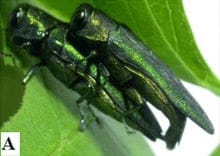The scourge of forests, the emerald ash borer, or EAB, is usually described with words like “destructive” and “pest.” A recent study based on data collected by citizen scientists suggests that one more adjective might apply, at least from a bird’s perspective: “delicious.”
In a study published this week in the journal Biological Invasions, U.S. Forest Service entomologist Andrew Liebhold and Cornell University scientist Walter Koenig and others document how an EAB invasion fueled a population boom for four species of birds in the Detroit area.
The four species of birds considered in the study “Effects of the emerald ash borer invasion on four species of birds” included three woodpeckers that are known to forage on EAB-infested ash trees – the downy woodpecker, hairy woodpecker, red-bellied woodpecker – as well as the white-breasted nuthatch, a common bark-gleaning species that is also a potential predator of EAB. All four species are cavity-nesters and also stand to benefit from an increase in nesting habitat as trees are killed by EAB.
“The emerald ash borer has been massively destructive because most North American ash trees have little or no defense against it,” Liebhold said. “We can take heart that native woodpecker species are clearly figuring out that EAB is edible, and this new and widely abundant food source appears to be enhancing their reproduction.”
Data used in the study were collected by volunteers for Project FeederWatch, a Cornell Lab of Ornithology and Bird Studies Canada project in which volunteers count birds that visit feeders at backyards, nature centers, community areas, and other locations from November through early April. The data helps scientists track movements of winter bird populations and long-term trends in bird distribution and abundance.
“Participants in citizen science projects contribute real, valuable data that allow us to tackle some major ecological questions related to invasive species, urbanization and habitat change, our changing climate, or other factors,” according to David Bonter, Project Leader of Project Feederwatch and a co-author on the study. “FeederWatchers are a particularly dedicated group, contributing more than 4.2 million hours of observation since 1987 and allowing us to track changes in the abundance and distribution of birds across North America.”
The study examined bird populations in an area about 25 miles west of downtown Detroit, where EAB was first discovered. Between the time EAB was first detected in 2002 and 2011, relative numbers of red-bellied woodpeckers and white-breasted nuthatches increased in abundance, scientists found. Populations of downy and hairy woodpeckers initially declined significantly and then fluctuated, however the downy woodpecker was at a significantly higher level relative to control sites during the 2009 bird survey season and hairy woodpecker populations were significantly higher during the 2011 season.
“Both for forests and urban trees, the emerald ash borer has been devastating,” said Michael T. Rains, Director of the U.S. Forest Service’s Northern Research Station and Director of the Forest Products Laboratory. “The Forest Service is helping cities and states prepare for and recover from EAB invasion with research on the insect, ash trees’ resistance to EAB, and biological control.”
Researchers compared the abundance of the four bird species to their abundance in two sets of sites where the impact of EAB has not yet been severe. These areas included sites approximately 50-100 km from the EAB epicenter, where the insect had caused some tree mortality but considerably less than what occurred in the epicenter of the outbreak. They also looked at abundance in five Midwestern cities similar in size to Detroit where EAB had not yet caused major damage but in some cases had been reported.
Co-authors on the study include Bonter, Wesley Hochachka, and. Janis L. Dickinson, all of Cornell University. Located in Ithaca, New York, Cornell is a major research university with strengths in the life sciences, physical sciences, humanities, and social sciences.


